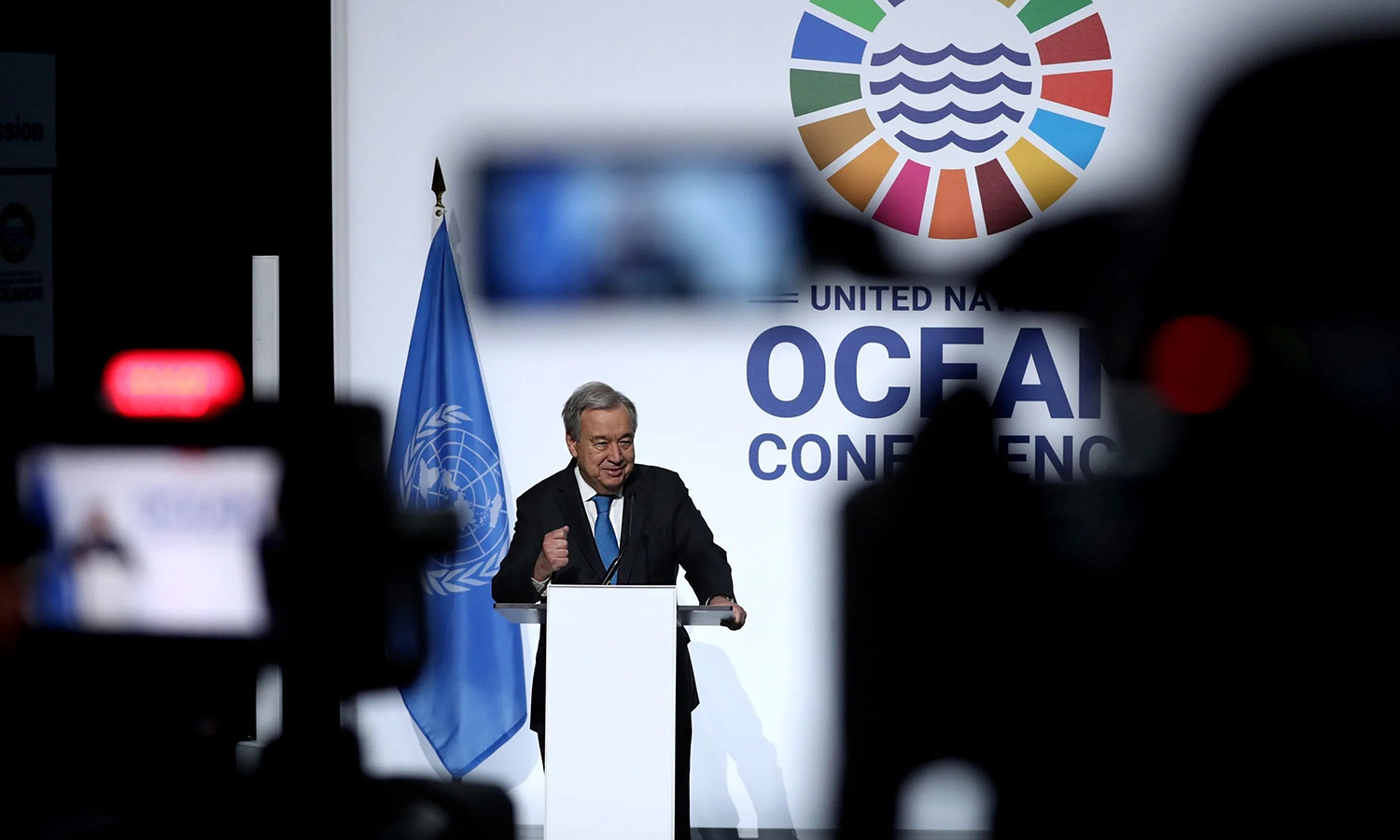
我們從海洋、河流、湖泊中生產或收獲的食物到達了一個拐點。魚類成為全世界交易量最高的大宗商品之一。水產養殖業是增長最快的食品工業。然而,這兩個行業將迅速達到可持續發展的極限。
在經歷過一連串聚焦于藍色經濟的全球事件之后,2022年聯合國海洋大會(2022 UN Ocean Conference)于6月27日開幕,政策制定者們有一次絕佳的機會考慮一種截然不同的發展方式。全世界只有加大力度維護整個藍色食品供應鏈的可持續性,才能夠避開其他農產品行業遭遇的困境,使更多人可以充分利用藍色食品,并避免資源枯竭或環境惡化。
雖然發達國家采取生態認證對改善生產標準做出了貢獻,但各國政府部門不能局限于當前的指標,而是應該強烈建議整個行業,從環境、社會和經濟等維度更加全面地思考可持續性。
可持續性首先要考慮到供應鏈中的生產者及其需求。依賴藍色食品為生的8億人,也是這個行業的基層工人,更是海洋和淡水生態系統健康的守護者。
當前的制度將數以百萬計的小生產者排除在外。他們沒有辦法和資源承擔昂貴的認證成本,達到認證的嚴格要求,但他們的缺位影響了整個行業,阻礙了實現真正可持續發展的進程。
隨著更多人能夠公平地參與藍色食品價值鏈,包括女性,他們將得到激勵和支持,為人類和環境創造更好的結果。
政策制定者可以支持這種積極轉變,例如執行更好的措施保護包括原住民社區在內的本地人的權利和參與機會,制定包容性政策等。公共監管部門可以制定標準,限制惡性補貼,避免影響藍色食品生產商采用更可持續的經營模式。
其次,藍色食品行業實現長期可持續性的關鍵在于,提高供應多樣化,避免過度依賴蝦、鮭魚和金槍魚等種類。多樣化的供應鏈不僅對全世界最大程度提高生活水準和食品安全至關重要,而且軟體類水產、海藻和小型魚類等物種還有更多營養價值。
超過3700種水生物種均含有不同程度的維生素、礦物質和脂肪酸,大幅增加水生物種的供應多樣化,預計能夠讓1.66億人避免微量營養素缺乏。
與此同時,許多藍色食品的環境影響與雞肉相當甚至更加出色,海藻和雙殼類動物,比如貽貝、生蠔等,所產生的溫室氣體排放最低。
最后,政策制定者還必須考慮如何確保全球和本地藍色食品市場能夠支持可持續生產、分銷和在對藍色食品需求最大的領域的可及性,包括學校供餐項目和本地貿易網絡等機制。
有40%的魚類被用于國際貿易,因此依賴藍色食物維持生計和獲取營養的沿海社區,必須能夠參與貿易并從中受益,以確保全球市場不會奪走窮人的營養來源,或者破壞他們賴以生存的生態環境。
此外,小型企業可以產生足夠的經濟效益,因此它們依舊能夠參與該行業并為其做出貢獻。例如,通過投資為小企業創造更多的機會,通過將藍色食品加工成更高附加值產品從中獲利,還可以從全球市場中獲得溢價,增加本地水產養殖價值鏈的生計。
通過執行恰當的政策,能夠引導最有影響力的企業重新定義可持續性:使小型生產商、加工商和貿易商、沿海和原住民社區,以及發展中國家都可以從中受益。(財富中文網)
本文作者菲奧倫扎·米凱利(Fiorenza Micheli)是斯坦福大學海洋解決方案中心(Stanford Center for Ocean Solutions)和霍普金斯海洋站(Hopkins Marine Station)的聯席主任,也是藍色食品評估(Blue Food Assessment)倡議的成員。
在Fortune.com上發表的評論文章中表達的觀點,僅代表作者本人的觀點,不代表《財富》雜志的觀點和立場。
譯者:劉進龍
審校:汪皓
我們從海洋、河流、湖泊中生產或收獲的食物到達了一個拐點。魚類成為全世界交易量最高的大宗商品之一。水產養殖業是增長最快的食品工業。然而,這兩個行業將迅速達到可持續發展的極限。
在經歷過一連串聚焦于藍色經濟的全球事件之后,2022年聯合國海洋大會(2022 UN Ocean Conference)于6月27日開幕,政策制定者們有一次絕佳的機會考慮一種截然不同的發展方式。全世界只有加大力度維護整個藍色食品供應鏈的可持續性,才能夠避開其他農產品行業遭遇的困境,使更多人可以充分利用藍色食品,并避免資源枯竭或環境惡化。
雖然發達國家采取生態認證對改善生產標準做出了貢獻,但各國政府部門不能局限于當前的指標,而是應該強烈建議整個行業,從環境、社會和經濟等維度更加全面地思考可持續性。
可持續性首先要考慮到供應鏈中的生產者及其需求。依賴藍色食品為生的8億人,也是這個行業的基層工人,更是海洋和淡水生態系統健康的守護者。
當前的制度將數以百萬計的小生產者排除在外。他們沒有辦法和資源承擔昂貴的認證成本,達到認證的嚴格要求,但他們的缺位影響了整個行業,阻礙了實現真正可持續發展的進程。
隨著更多人能夠公平地參與藍色食品價值鏈,包括女性,他們將得到激勵和支持,為人類和環境創造更好的結果。
政策制定者可以支持這種積極轉變,例如執行更好的措施保護包括原住民社區在內的本地人的權利和參與機會,制定包容性政策等。公共監管部門可以制定標準,限制惡性補貼,避免影響藍色食品生產商采用更可持續的經營模式。
其次,藍色食品行業實現長期可持續性的關鍵在于,提高供應多樣化,避免過度依賴蝦、鮭魚和金槍魚等種類。多樣化的供應鏈不僅對全世界最大程度提高生活水準和食品安全至關重要,而且軟體類水產、海藻和小型魚類等物種還有更多營養價值。
超過3700種水生物種均含有不同程度的維生素、礦物質和脂肪酸,大幅增加水生物種的供應多樣化,預計能夠讓1.66億人避免微量營養素缺乏。
與此同時,許多藍色食品的環境影響與雞肉相當甚至更加出色,海藻和雙殼類動物,比如貽貝、生蠔等,所產生的溫室氣體排放最低。
最后,政策制定者還必須考慮如何確保全球和本地藍色食品市場能夠支持可持續生產、分銷和在對藍色食品需求最大的領域的可及性,包括學校供餐項目和本地貿易網絡等機制。
有40%的魚類被用于國際貿易,因此依賴藍色食物維持生計和獲取營養的沿海社區,必須能夠參與貿易并從中受益,以確保全球市場不會奪走窮人的營養來源,或者破壞他們賴以生存的生態環境。
此外,小型企業可以產生足夠的經濟效益,因此它們依舊能夠參與該行業并為其做出貢獻。例如,通過投資為小企業創造更多的機會,通過將藍色食品加工成更高附加值產品從中獲利,還可以從全球市場中獲得溢價,增加本地水產養殖價值鏈的生計。
通過執行恰當的政策,能夠引導最有影響力的企業重新定義可持續性:使小型生產商、加工商和貿易商、沿海和原住民社區,以及發展中國家都可以從中受益。(財富中文網)
本文作者菲奧倫扎·米凱利(Fiorenza Micheli)是斯坦福大學海洋解決方案中心(Stanford Center for Ocean Solutions)和霍普金斯海洋站(Hopkins Marine Station)的聯席主任,也是藍色食品評估(Blue Food Assessment)倡議的成員。
在Fortune.com上發表的評論文章中表達的觀點,僅代表作者本人的觀點,不代表《財富》雜志的觀點和立場。
譯者:劉進龍
審校:汪皓
The food we produce or harvest from the oceans, rivers, and lakes is at an inflection point. Fish has become one of the most traded commodities in the world. Aquaculture is the fastest-growing food industry. However, both sectors are rapidly approaching the limits of sustainability.
With the UN Ocean Conference getting underway this week in Lisbon after a string of global events focused on the blue economy, policymakers have a unique window of opportunity to consider an entirely different approach. Only by ambitiously entrenching the sustainability of blue foods across supply chains will the world be able to avoid the pitfalls of other agri-food sectors and enable more people to get the best out of blue foods, without exhausting these resources or degrading the environment.
While eco-certification has made an important contribution towards improving production standards in the Global North, governments and agencies worldwide must move beyond current metrics and challenge the entire sector to think more comprehensively about sustainability to include environmental, social, and economic dimensions.
Sustainability must start where supply chains do: with the producers and their needs. The 800 million men and women who depend on blue foods for their livelihoods are also the sector’s frontline workers and the stewards of marine and freshwater ecosystem health.
Current schemes exclude millions of small-scale producers who lack the means and resources to bear the high costs of certification and meet its stringent bar, but their absence undermines the sector at large and hinders progress towards true sustainability.
With more of the diverse actors in the blue food value chain–including women–able to participate more equitably, they will be incentivized and supported to create better outcomes for people and the environment.
Policymakers can support this positive transformation by implementing better protections for local rights and access, including those of indigenous communities, and inclusive policies. Public regulators can introduce standards to limit harmful subsidies that undermine the ability of blue food producers to adopt more sustainable practices.
Secondly, the long-term sustainability of the blue food sector hinges on increasing the diversity in supply to avoid the dangers of an over-reliance on shrimp, salmon, and tuna. Not only is a diverse supply chain critical for maximizing the potential for decent livelihoods and food security around the world, but it also unlocks a greater range of nutritional benefits from species like mollusks, seaweed, and small fish.
With more than 3,700 aquatic species all containing different levels of vitamins, minerals, and fatty acids, sustainably increasing and diversifying supply could prevent micronutrient deficiencies for a projected 166 million people.
Meanwhile, many blue foods outperform or compare to chicken in terms of environmental impact, with seaweeds and bivalves like mussels and oysters generating the lowest levels of greenhouse gas emissions.
Finally, policymakers must also consider how to ensure global and local markets for blue foods support the sustainable production, distribution, and availability of blue foods where they are most needed, including mechanisms such as school feeding programs and local trade networks.
With as much as 40% of fish traded internationally, coastal communities who depend on blue foods for their livelihoods and nutrition must be enabled to participate and benefit to ensure global markets are not taking nutrients from the mouths of the poor or degrading the ecosystems that are essential to their livelihoods.
It is also critical that small-scale actors can reap adequate economic benefits so that they can remain engaged and contribute to the sector. For example, investing in more opportunities for small-scale operations to also benefit from processing blue foods into higher-value products, which often attract a premium from global markets, will increase the livelihoods of local aquaculture value chains.
With the right policies, the most powerful players can be directed towards a new definition of sustainability: one that also allows small-scale producers, processors and traders, coastal and indigenous communities, and developing countries to benefit.
Fiorenza Micheli is the co-director of the Stanford Center for Ocean Solutions and Hopkins Marine Station and a member of the Blue Food Assessment initiative.
The opinions expressed in Fortune.com commentary pieces are solely the views of their authors and do not reflect the opinions and beliefs of Fortune.






